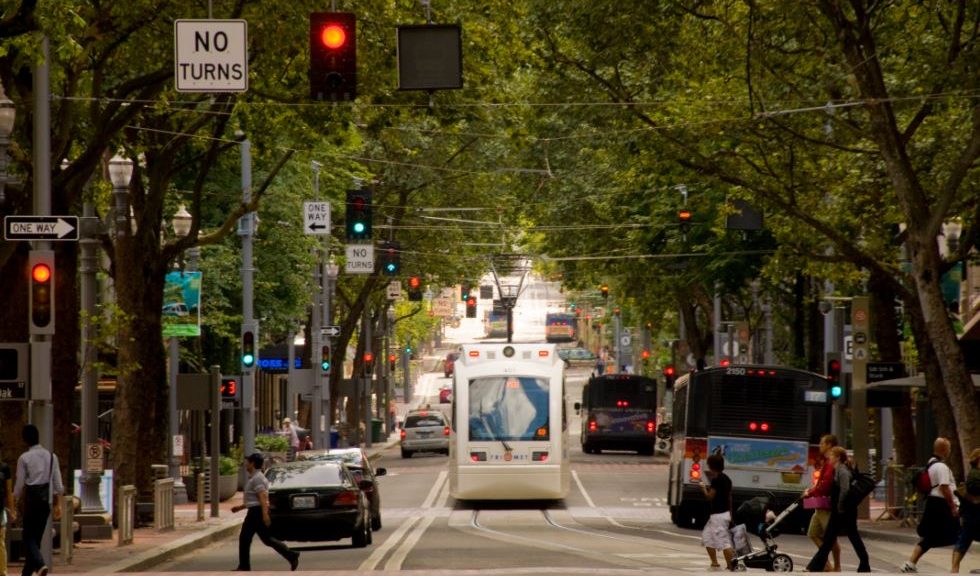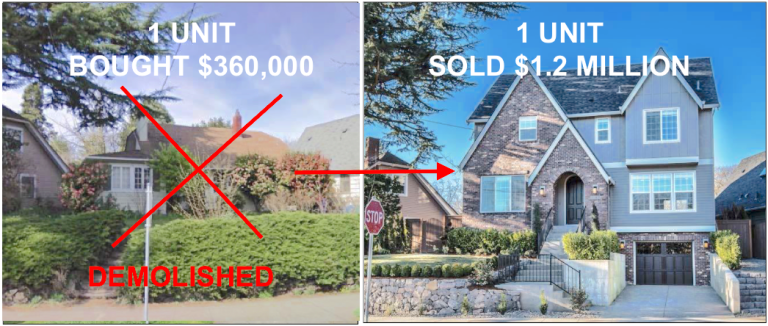
Free-for-All: Development in Portland
I’ve spent some time here talking about the problems associated with folks who don’t want to allow new building in their neighborhoods. Whether operating under the guise of NIMBYism (“Not in My Backyard”) or historic preservation, there are real dangers and real implications for cities not allowing new building. As people continuously move back into urban areas, demand is outstripping supply, leading to increased prices. There are enormous consequences of this demographic shift: groups’ access to jobs, transportation, social services, green space, commercial districts, and other amenities are all shifting, and already marginalized communities (precisely the communities whose access to amenities most directly increases overall public good) are being pushed to less valuable areas. What’s more, in most areas, developers recognize that increasing density is a profitable development strategy. Because people are clamoring for homes, fitting more homes to a given acre of land is in the best interest of residents and developers, if not in the best interest of landlords and home owners who have a financial interest in constricting supply to artificially raise rents.
There are, as always, caveats to the above analysis. The first and most important consideration is how much more expensive it is to build up rather than out. There’s a reason areas like Houston, Dallas, and Phoenix are the quickest growing cities in the country: by adding low density housing further and further out from the central city, they are able to put up tons of inexpensive housing (Sprawl has massive public costs as well: low-density housing causes things to be super spread out, leading to huge commutes and an over-reliance on cars and environmental degradation). Because of how expensive dense construction is, developers have tended to focus on the high-end of the market. Luxury buyers are more willing and able to absorb these high costs. When we talk about the best way to encourage new development, we do need to have one eye on what development is being built, and whether the city ought to be using incentives and the zoning code to encourage different types of building. This might be through tax incentives (IE, making mid-market housing cheaper), increased taxes at the top (such as taxing absentee owners parking their capital), or other zoning incentives (such as allowing developers to build bigger buildings if they ensure that some units will be considered “affordable” as defined by the city). Encouraging general building is a good thing, but encouraging the right type of building is so much more important.
So why’s this important right now? Tina Kotek, an Oregon state representative, has introduced a bill in Salem that styles itself on the newly fashionable anti-NIMBY narrative. House Bill 2007 looks to significantly reduce restrictions on development in the Portland area, ostensibly in an attempt to spur new development in the face of rising rents. Since 2010, rents in Portland have increased by nearly 60% – an outrageously high number. While rents in the city are still well below those in other cities many city residents have been feeling a squeeze. While there’s some evidence that the building boom in the city is having some success at slowing rent growth, the positive impacts have been largely confined to the downtown area, while rent growth continues apace elsewhere.
On its face, House Bill 2007 seems eminently reasonable. Let’s get rid of nosy environmental regulations, land use restrictions, and city control over what gets built. To an extent, the logic makes sense. Increased regulations make things more expensive for developers, and these costs are ultimately passed through to the end users of the buildings. By reducing oversight, developers will put up more units more quickly. This will lead to an increase in supply paralleling increasing demand, leading to price stabilization.
There are a few problems with the argument, some more important than others. The first problem comes from a number pointed out above – housing prices in Portland are significantly lower than they are for other comparable cities. The average one-bedroom apartment in Portland goes for just under $1,100 per month. That’s compared to just over $1,430 USD per month in Vancouver, $2,000 in Seattle, $2,200 in LA, and $3,400 in San Francisco. Despite recent growth in costs, Portland remains far below these other west coast cities. To a certain extent, we would expect some level of parity between these cities. When we consider Portland’s storied quality of life, its urban growth boundary, and the housing costs in other west coast cities, it is perhaps surprising that housing is as cheap as it is currently. While painful and problematic for current residents, there is a certain level of housing cost increase that will occur in Portland in the coming years regardless of any policy.
The second problem with Kotek’s “Build, Baby, Build” bill has to do with the type of development Portland ought to be encouraging. Her bill doesn’t seem to encourage any particular type of building, but simply to make all new development across the board easier. In an ideal world, the city would be encouraging denser development to replace single family lots. Importantly, this doesn’t mean replacing single family homes with buildings with dozens of units – replacing typical homes with bungalows or townhouses would do much to add the new units needed without drastically changing neighborhood characteristics. In the world of urban planning, we spend a lot of time talking about the “missing middle” – we know how to build sprawling, single family plots and how to build apartment buildings, but aren’t nearly as good at building middle density (roughly 15-40 units/acre). In an ideal world, Portland would find ways not to create more ugly black glass boxes, but rather to shift the left-most part of this diagram right:

Middle density has a huge number of benefits. A clustering of many residents make small stores economically viable, boosting local employment. The presence of small, local shops means residents are more able to run daily errands on foot, boosting public health. Smaller homes, and homes with shared walls, are much more environmentally friendly. Living close together makes public transit significantly more viable. The list goes on.
In actuality, much of the development happening in Portland that the current House Bill would make easier looks more like this, one of Portland’s 376 residential demolitions in 2016:

This is what market rate development looks like when a city foregoes its ability to encourage the right sort of development. This change doesn’t reflect a market clamoring for more space. It doesn’t reflect a city’s ability to build more supply as demand increases. This development added no new supply to the market, and actively took a very affordable home and placed it out of reach for most new home buyers. This development actively made the housing situation worse in Portland. Kotek’s bill would do nothing to encourage a shift to middle density housing over conversions of this sort; it would simply make all development across the board more simple. Why should Oregon accept a bill that makes even conversions like the one above, conversions that actively harm the public good, easier?
A few weeks ago, I wrote that YIMBYs need to start widening the scope of what we talk about. Having made the case for more development, we need to start talking about what needs to happen in addition to development. Kotek’s bill is an excellent starting place. Although Kotek attempts to align her plan with YIMBYs, we should reject that. Encouraging new development is important, but not all development is good and we should resist any attempt to characterize our position as such. There are real ways Portland can encourage the sort of development that will keep a lid on housing cost growth. Picking the parking minimum conversation the City Council punted on last year would be a great place to start. If developers aren’t required to include a minimum number of parking spaces every time they build new apartments, they can build more densely and attract residents who are likely to use more public transit – both of which are beneficial to the larger community. Of course, encouraging particular types of development is harder than simply setting a green light, but Portland shouldn’t back down from a difficult challenge with such important ramifications.